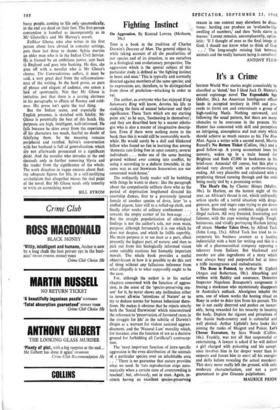It's a Crime
SECOND World War stories might conceivably be classified as 'dated,' but I liked Jack D. Hunter's second espionage novel The Expendable Spy (Muller, 20s.). An American Intelligence officer lands in occupied territory in 1945 and pro- ceeds to ferret out and exterminate a group of high-ranking Nazis. Nothing untoward, and following the usual pattern, but there are many obstacles to be overcome in the process. Mr Hunter has concocted with skill and perception an intriguing, atmospheric and taut story which should achieve as much success as his The Blue Max. Again a writer with a second novel, Martin Russell's No Return Ticket (Collins, 16s.) and a good follow-up. A young accountant loses his memory, wakes up in a train bound for Brighton and finds £7,000 in banknotes in his brief-case. Amnesia? Of course, but this plot is devised very cleverly with an eyebrow-raising ending. All very plausible and calculated with a perplexing thread running through and the ends being neatly tied by a promising writer.
The Heat's On, by Chester Himes (Muller, 18s.). In Harlem, on the hottest night of the year, an African's throat is cut, which unfriendly action sparks off a torrid situation with drugs, gunmen, gore and negro cops trying to pin down a Sister Heavenly who combines religion with illegal rackets. All very frenzied, frustrating and fulsome, with the cops winning through. Tough, boisterous, and vividly portraying Harlem letting off steam. Murder Takes Over, by Alfred Tack (John Long, 15s.). Alfred Tack has tried to in- corporate his business acumen as a leading industrialist with a bent for writing and this is a tale of a pharmaceutical company opposing a takeover from Italians. But blackmail and murder are also ingredients of a story which was always busy and purposeful but at times a trifle incongruous and melodramatic.
The Bone is Pointed, by Arthur W. Upfield (Angus and Robertson, 18s.). Absorbing and written with fluidity and assurance. Detective Inspector Napoleon Bonaparte's assignment is tracing a stockman who mysteriously disappears in Australia's outback. Aborigines inhabit the area, one of whom works the boning ritual on Bony in order to deter him from his pursuit. The tec is not easily deterred and pushes on inexor- ably, being rewarded for his tenacity in locating the body. Depicts the rigours and privations of the Aussie bush-country and is colourful and well plotted. Arthur Upfield's hero looks like joining the ranks of Maigret and Poirot. Let's Choose Executors, by Sara Woods (Collins, 16s.). Frankly, was not all that suspenseful or entertaining. A lawyer is asked if he will defend a girl charged with poisoning and his accept- ance involves him in far deeper water than he suspects and forces him to exert all his energies and skills before revealing the actual murderer. This story never really left the ground, with only moderate characterisation, and not a yarn guaranteed to give Grannie palpitations.
MAURICE PRIOR


































 Previous page
Previous page